Study on Supersonic Dehydration Efficiency of High Pressure Natural Gas
Abstract
1. Introduction
2. Numerical Methods
2.1. Gas phase Governing Equations
2.2. Liquid Phase Governing Equations
2.3. The Supersonic Cyclone Separator Geometry
2.4. Mesh Strategy
2.5. Solving Methods and Boundary Conditions
2.6. Model Verification
3. Results and Discussions
3.1. Gas Flow Field
3.2. Droplet Trajectory
3.3. Separation Efficiency
3.3.1. Effects of the Diameter of Droplets on the Separation Efficiency
3.3.2. Effect of Gas–Liquid Area Ratio on Separation Efficiency
3.3.3. Effects of the Number of Vanes on the Separation Efficiency
4. Conclusions
- (1)
- Laval nozzle and swirler of supersonic cyclone separators were the core components to affect the dewatering efficiency of the device. Laval nozzle could provide the necessary conditions for the condensation of water vapor in the supersonic state, droplets with sufficient centrifugal force were thrown to the wall or into the separator to achieve gas–liquid separation process by the swirler.
- (2)
- The trajectories of droplets in the supersonic cyclone separator were predicted. Droplets had three typical trajectories affected by centrifugal effect and inertia effect. The existence of a shock wave increases the swirl intensity of droplets, which is conducive to the separation of droplets.
- (3)
- In order to improve the efficiency of a supersonic cyclone separator and promote the sustainable development of the natural gas industry, the diameter of droplets should be increased as much as possible, the gas–liquid area ratio should be about 45.25%, and the number of vanes should be to 10.
Author Contributions
Funding
Conflicts of Interest
References
- Fu, M.; Yang, Y.; Tian, L.; Zhen, Z. The Spatiotemporal Dynamics of Natural Gas Imports in OECD Countries. Sustainability 2017, 9, 2106. [Google Scholar] [CrossRef]
- Wang, B.; Liu, X.J.; Xiong, Z.; Cheng, J.J.; Yang, B.; Yu, C.H. Corrosion reasons and control measures of a natural gas pipeline. Surf. Technol. 2018, 47, 89–94. [Google Scholar] [CrossRef]
- Mokhatab, S.; Wilkens, R.J.; Leontaritis, K.J. A review of strategies for solving gas-hydrate problems in subsea pipelines. Energy Sources 2007, 29, 39–45. [Google Scholar] [CrossRef]
- Elendu, C.C.; Ude, C.N.; Odoh, E.E.; Ihedioha, O.J. Natural gas dehydration with triethylene glycol (TEG). Eur. Sci. J. 2015, 11, 68–78. [Google Scholar]
- Ohlrogge, K.; Brinkmann, T. Natural gas cleanup by means of membranes. Ann. N. Y. Acad. Sci. 2010, 984, 306–317. [Google Scholar] [CrossRef] [PubMed]
- Myrlla, G.R.S.S.; Leilane, M.S.C.; José, L.M.; Oféliade, Q.F.A. Natural gas dehydration by molecular sieve in offshore plants: Impact of increasing carbon dioxide content. Energy Convers. Manag. 2017, 149, 760–773. [Google Scholar]
- Shang, J. Experimental research on the expansion refrigeration technology for natural gas dehydration and dealkylation. Liaoning Chem. Ind. 2014, 43, 1339–1341. [Google Scholar]
- Duan, Z.Y.; Liang, L.H.; Li, S.; Liu, Z.; Li, Z.J.; Liu, X.Z. Natural gas supersonic cyclone separation technology with the integration of condensation and centrifugation. Nat. Gas Ind. 2018, 38, 93–99. [Google Scholar]
- Betting, M.; Epsom, H. Supersonic separator gains market acceptance. World Oil 2007, 4, 197–200. [Google Scholar]
- Karimi, A.; Abdi, M.A. Selective dehydration of high-pressure natural gas using supersonic nozzles. Chem. Eng. Process. Process Intensif. 2009, 48, 560–568. [Google Scholar] [CrossRef]
- Wen, C.; Cao, X.; Yang, Y.; Zhang, J. Evaluation of natural gas dehydration in supersonic swirling separators applying the Discrete Particle Method. Adv. Powder Technol. 2012, 23, 228–233. [Google Scholar] [CrossRef]
- Wen, C.; Cao, X.; Yang, Y.; Li, W.L. Numerical simulation of natural gas flows in diffusers for supersonic separators. Energy 2012, 37, 195–200. [Google Scholar] [CrossRef]
- Vaziri, B.M.; Shahsavand, A. Analysis of supersonic separators geometry using generalized radial basis function (GRBF) artificial neural networks. J. Nat. Gas Sci. Eng. 2013, 13, 30–41. [Google Scholar] [CrossRef]
- Niknam, P.H.; Mortaheb, H.R.; Mokhtarani, B. Optimization of dehydration process to improve stability and efficiency of supersonic separation. J. Nat. Gas Sci. Eng. 2017, 43, 90–95. [Google Scholar] [CrossRef]
- Wen, C.; Cao, X.W.; Yang, Y.; Zhang, J. Swirling effects on the performance of supersonic separators for natural gas separation. Chem. Eng. Technol. 2011, 34, 1575–1580. [Google Scholar] [CrossRef]
- Wen, C.; Yang, Y.; Walther, J.H.; Pang, K.M.; Feng, Y.Q. Effect of delta wing on the particle flow in a novel gas supersonic separator. Powder Technol. 2016, 304, 261–267. [Google Scholar] [CrossRef]
- Ma, Q.F.; Hu, D.P.; He, G.H.; Hu, S.J.; Liu, W.W.; Xu, Q.L.; Wang, Y.X. Performance of inner-core supersonic gas separation device with droplet enlargement method. Chin. J. Chem. Eng. 2009, 17, 925–933. [Google Scholar] [CrossRef]
- Hu, D.P.; Wang, Y.G.; Ren, W.W.; Zhao, J.H.; Liu, P.Q. Flow characteristic of supersonic gas separator with diversion cone. CIESC J. 2016, 67, 2417–2425. [Google Scholar]
- Hu, D.P.; Wang, Y.G.; Ma, C. Numerical simulation of supersonic separator with axial or tangential outlet in reflow channel. Chem. Eng. Process. Process Intensif. 2018, 124, 109–121. [Google Scholar] [CrossRef]
- Bian, J.; Jiang, W.M.; Teng, L.; Liu, Y.; Wang, S.W.; Deng, Z.F. Structure improvements and numerical simulation of supersonic separators. Chem. Eng. Process. Process Intensif. 2016, 110, 214–219. [Google Scholar] [CrossRef]
- Cao, X.W.; Yang, W. The dehydration performance evaluation of a new supersonic swirling separator. J. Nat. Gas Sci. Eng. 2015, 27, 1667–1676. [Google Scholar] [CrossRef]
- Wen, C.; Cao, X.W.; Wu, L.H. Structure design and numerical simulation of a novel supersonic swirling separator. J. China Univ. Pet. 2010, 34, 119–122. [Google Scholar]
- Yang, Y.; Wen, C.; Wang, S.L.; Feng, Y.Q. Theoretical and numerical analysis on pressure recovery of supersonic separators for natural gas dehydration. Appl. Energy 2014, 132, 248–253. [Google Scholar] [CrossRef]
- Liu, X.W.; Liu, Z.L. Numerical investigation and improvement strategy of flow characteristics inside supersonic separator. Sep. Sci. Technol. 2017, 53, 940–952. [Google Scholar] [CrossRef]
- Eriqitai; Han, J.; Duan, R.; Wu, M. Performance of dual-throat supersonic separation device with porous wall structure. Chin. J. Chem. Eng. 2014, 22, 370–382. [Google Scholar] [CrossRef]
- Liu, X.W.; Liu, Z.L.; Li, Y.X. Investigation on separation efficiency in supersonic separator with gas-droplet flow based on DPM approach. Sep. Sci. Technol. 2014, 49, 2603–2612. [Google Scholar] [CrossRef]
- Yang, Y.; Wen, C. CFD modeling of particle behavior in supersonic flows with strong swirls for gas separation. Sep. Purif. Technol. 2017, 174, 22–28. [Google Scholar] [CrossRef]
- Vaziri, B.M.; Shahsavand, A. Optimal selection of supersonic separators inlet velocity components via maximization of swirl strength and centrifugal acceleration. Sep. Sci. Technol. 2015, 50, 752–759. [Google Scholar] [CrossRef]
- Malyshkina, M.M. The procedure for investigation of the efficiency of purification of natural gases in a supersonic separator. High Temp. 2010, 48, 244–250. [Google Scholar] [CrossRef]
- Jiang, W.; Bian, M.J.; Wu, A.; Gao, S.; Hou, D.Y. Investigation of supersonic separation mechanism of CO2 in natural gas applying the Discrete Particle Method. Chem. Eng. Process. Process Intensif. 2018, 123, 272–279. [Google Scholar] [CrossRef]
- Yang, Y.; Li, A.Q.; Wen, C. Optimization of static vanes in a supersonic separator for gas purification. Fuel Process. Technol. 2017, 156, 265–270. [Google Scholar] [CrossRef]
- Wen, C.; Cao, X.W.; Yan, B.; Zhang, J. Optimization design of diffusers for supersonic separators. Appl. Mech. Mater. 2010, 44–47, 1913–1917. [Google Scholar] [CrossRef]
- Alobaid, F. A particle-grid method for Euler-Lagrange approach. Powder Technol. 2015, 286, 342–360. [Google Scholar] [CrossRef]
- Morsi, S.A.; Alexander, A.J. An investigation of particle trajectories in two-phase flow systems. J. Fluid Mech. 2006, 55, 193–208. [Google Scholar] [CrossRef]
- Zhou, C.; Duan, Z.Y.; Zhang, T.; Fan, L.J.; Liu, X.Z.; Liu, Y.Z.; Jia, W.G. Design and numerical optimization of natural gas supersonic dehydration unit swirl parts. Chem. Eng. (China) 2017, 45, 63–67. [Google Scholar] [CrossRef]
- Jiang, W.M.; Liu, Z.L.; Liu, X.L.; Li, G.S.; Liu, J.D. Experimental study on wet air in supersonic condensation flows. CIESC J. 2011, 62, 97–102. [Google Scholar]
- Wen, C.; Cao, X.W.; Yang, Y. Swirling flow of natural gas in supersonic separators. Chem. Eng. Process. Process Intensif. 2011, 50, 644–649. [Google Scholar] [CrossRef]
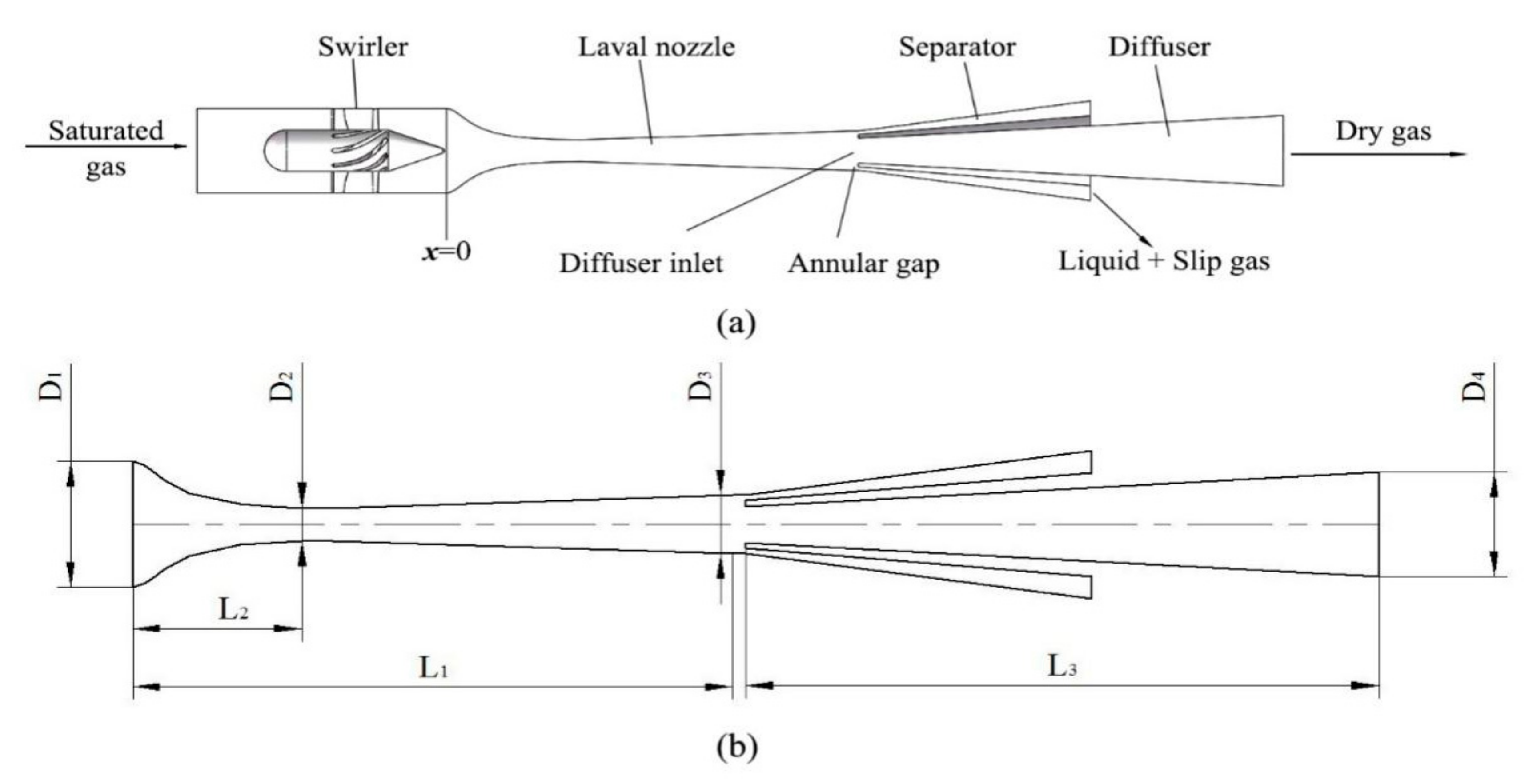
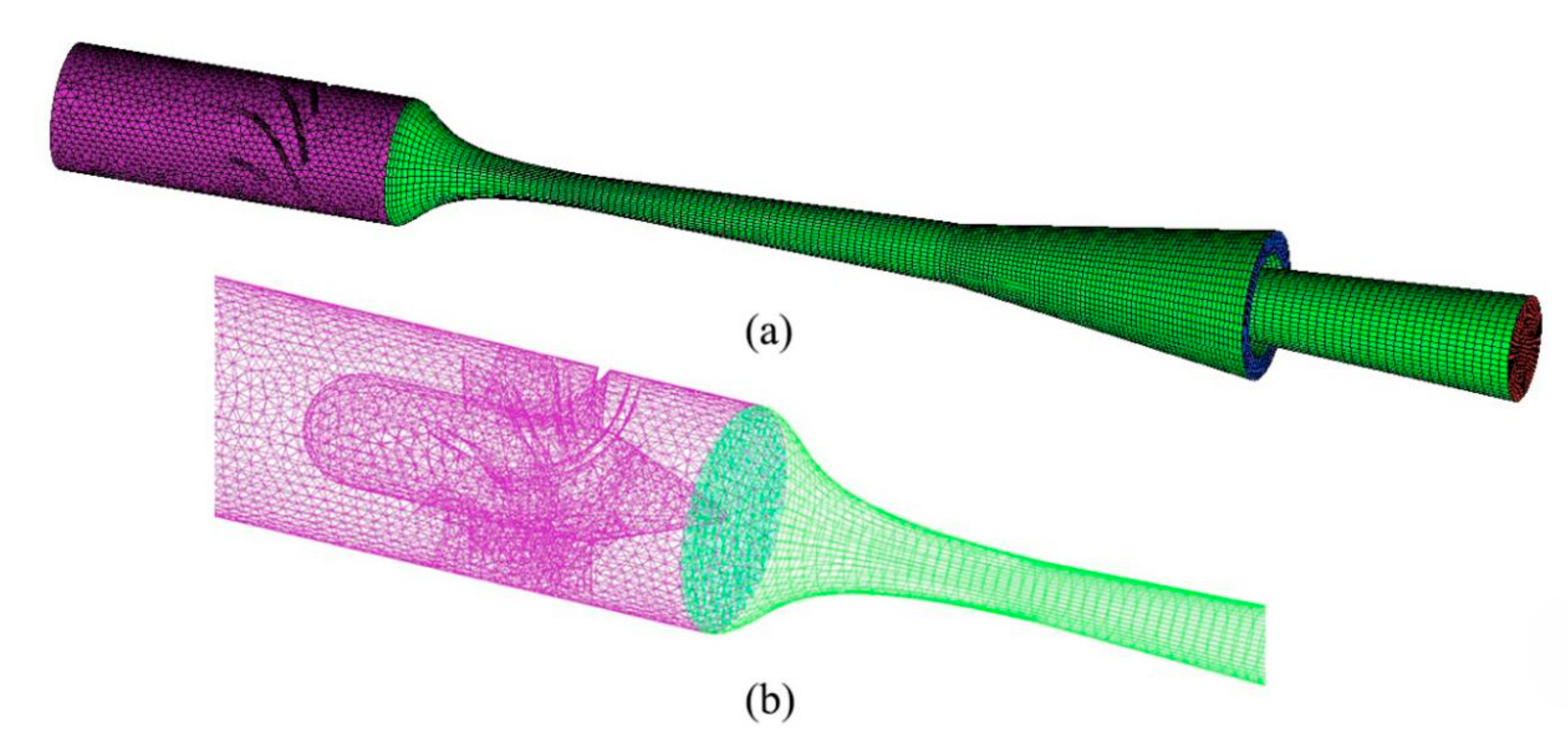
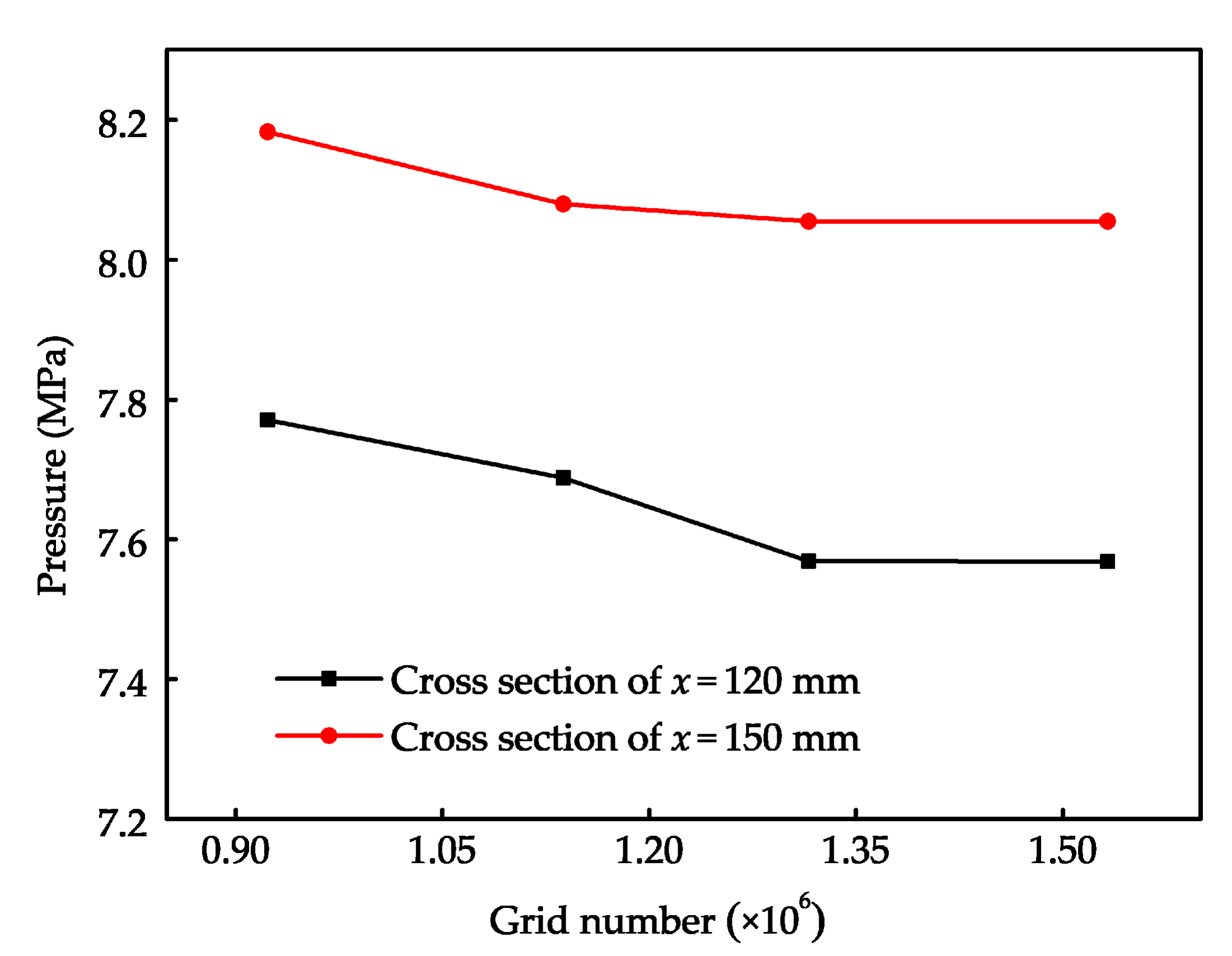

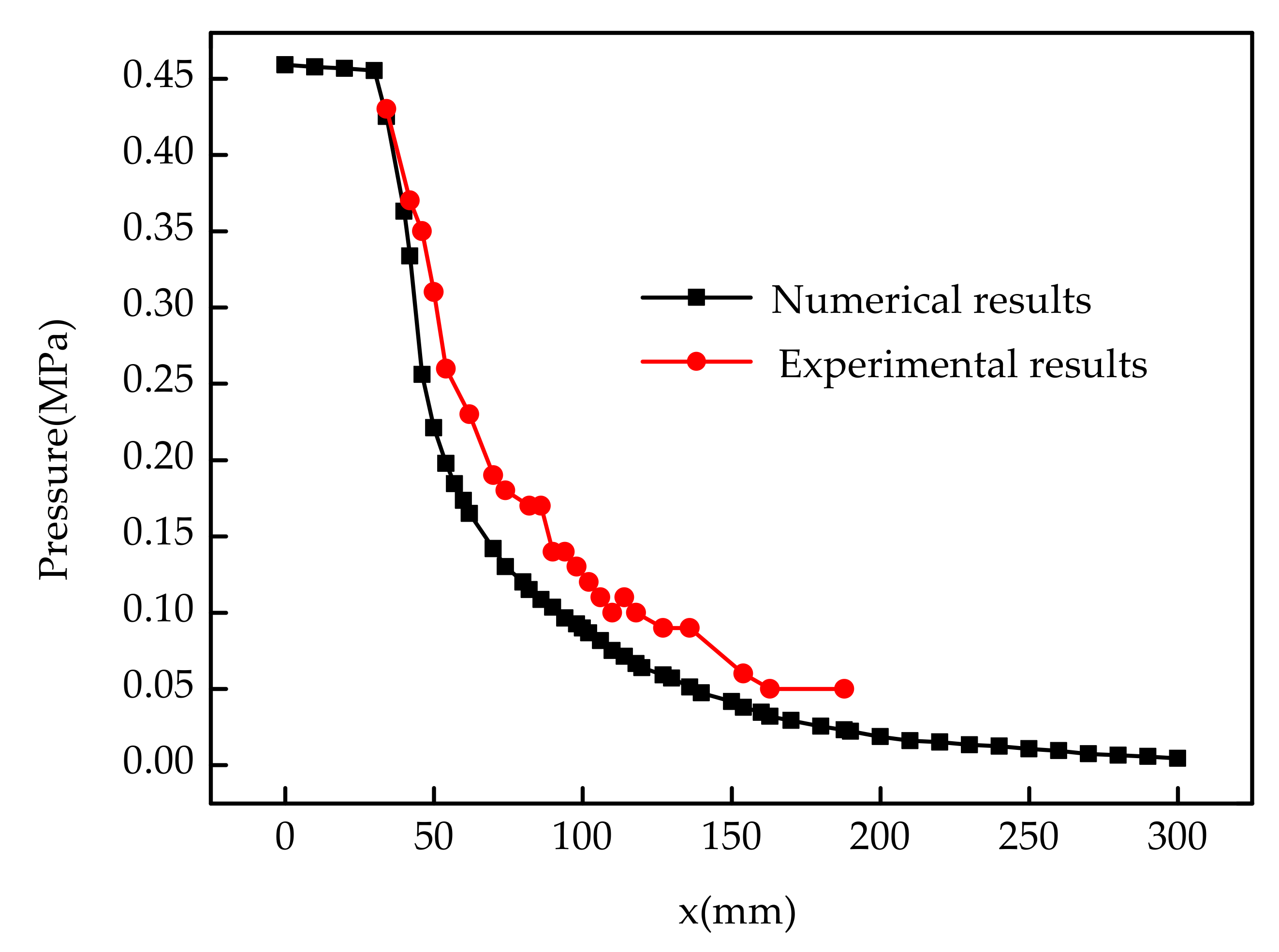
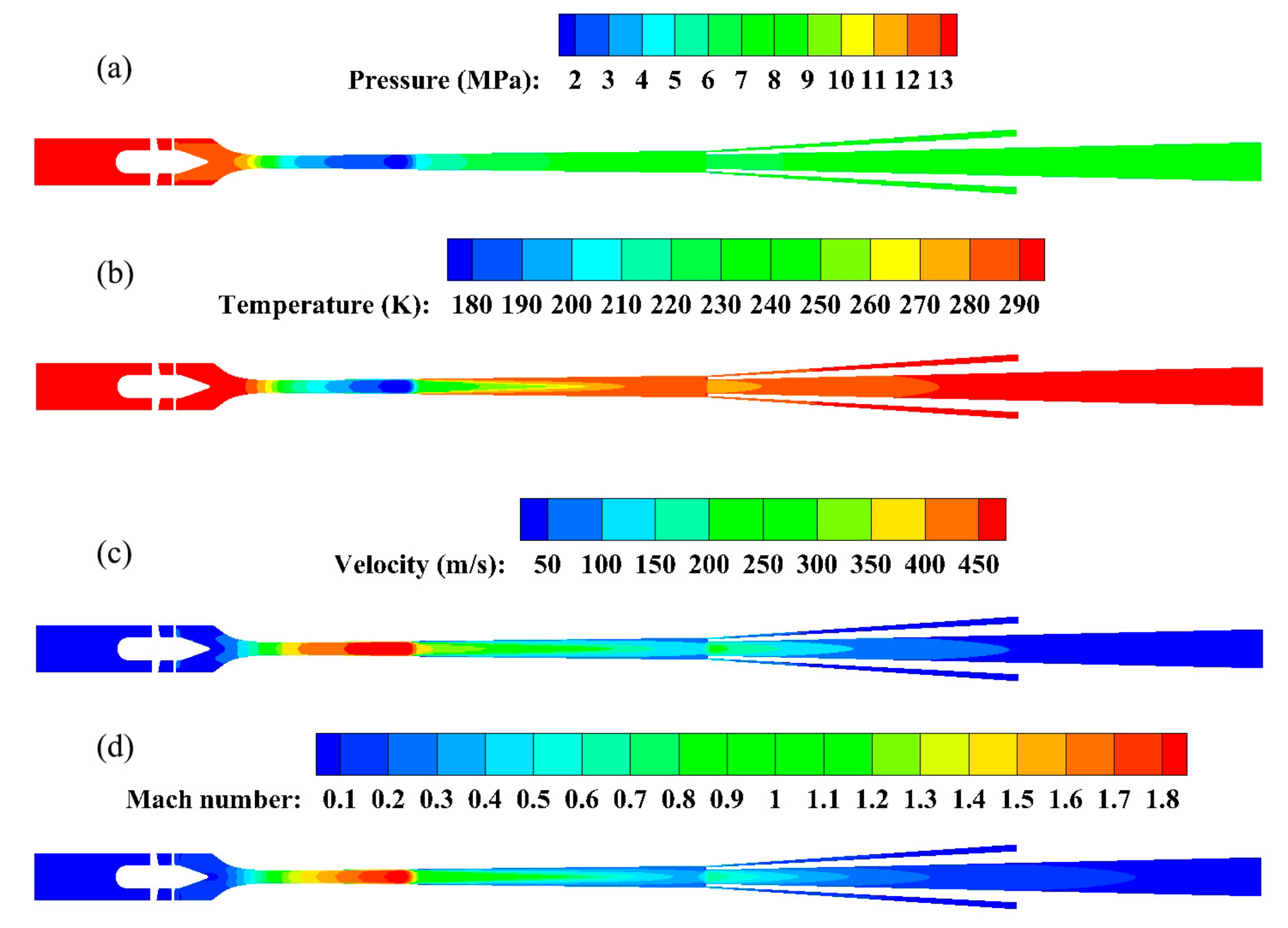
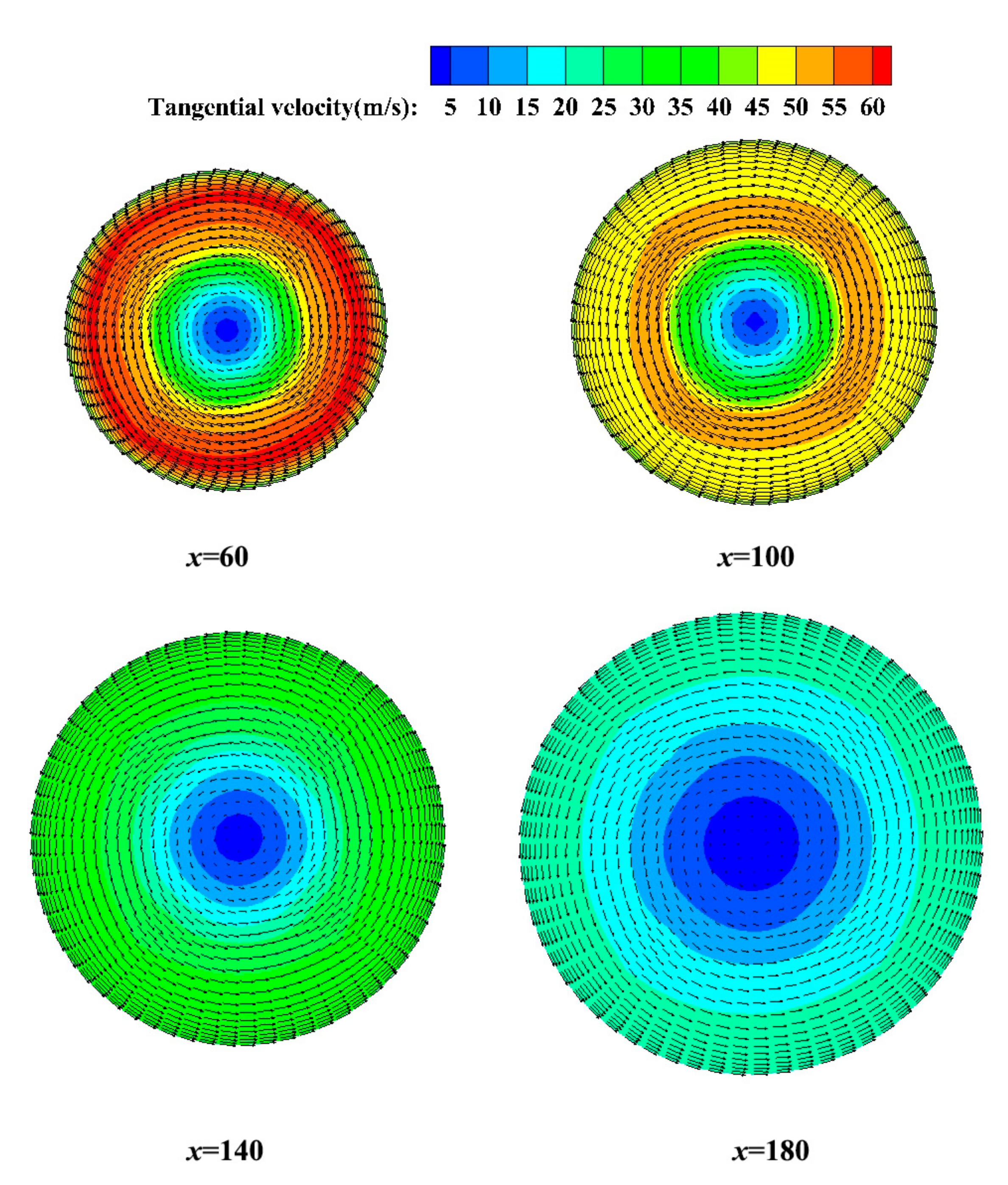

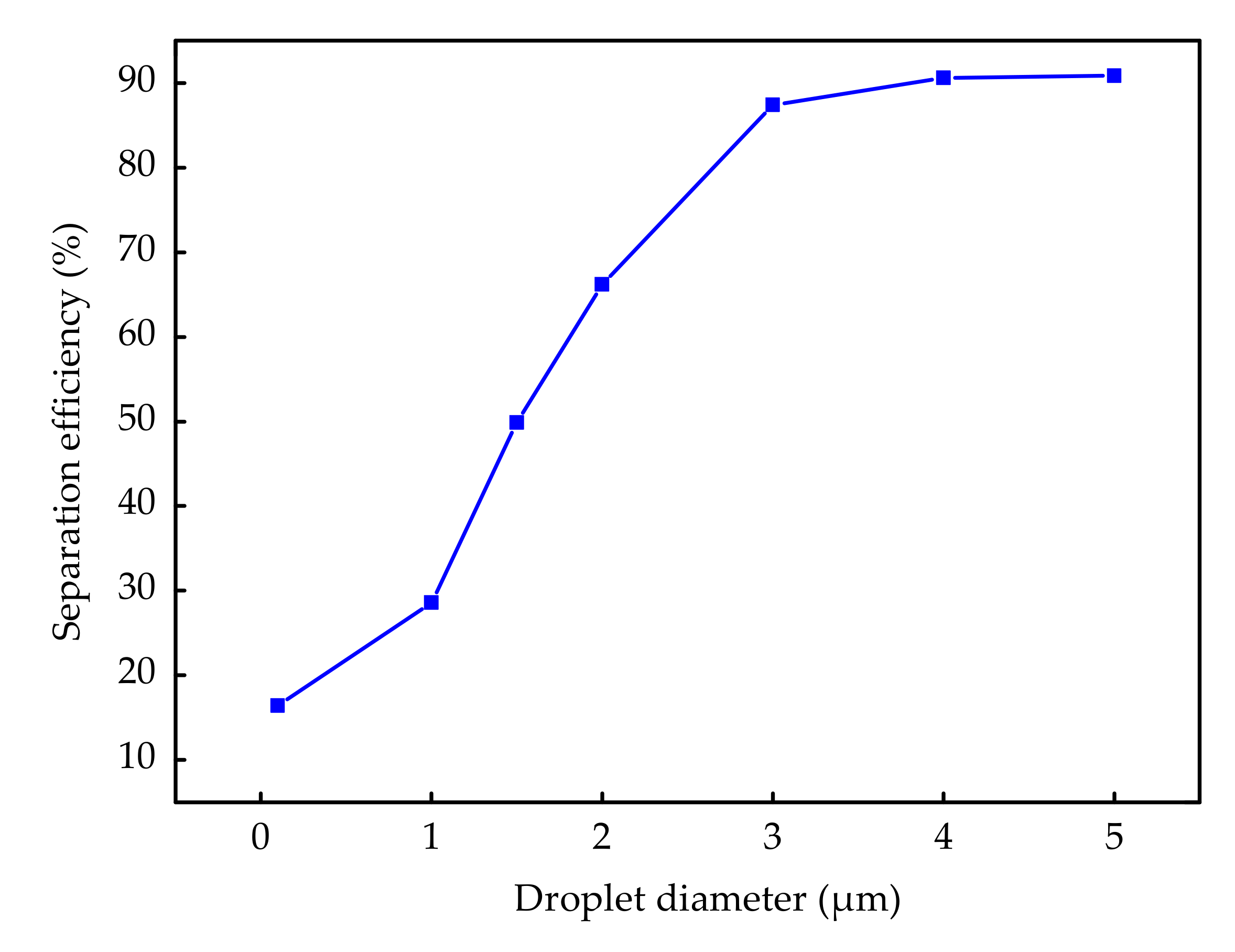
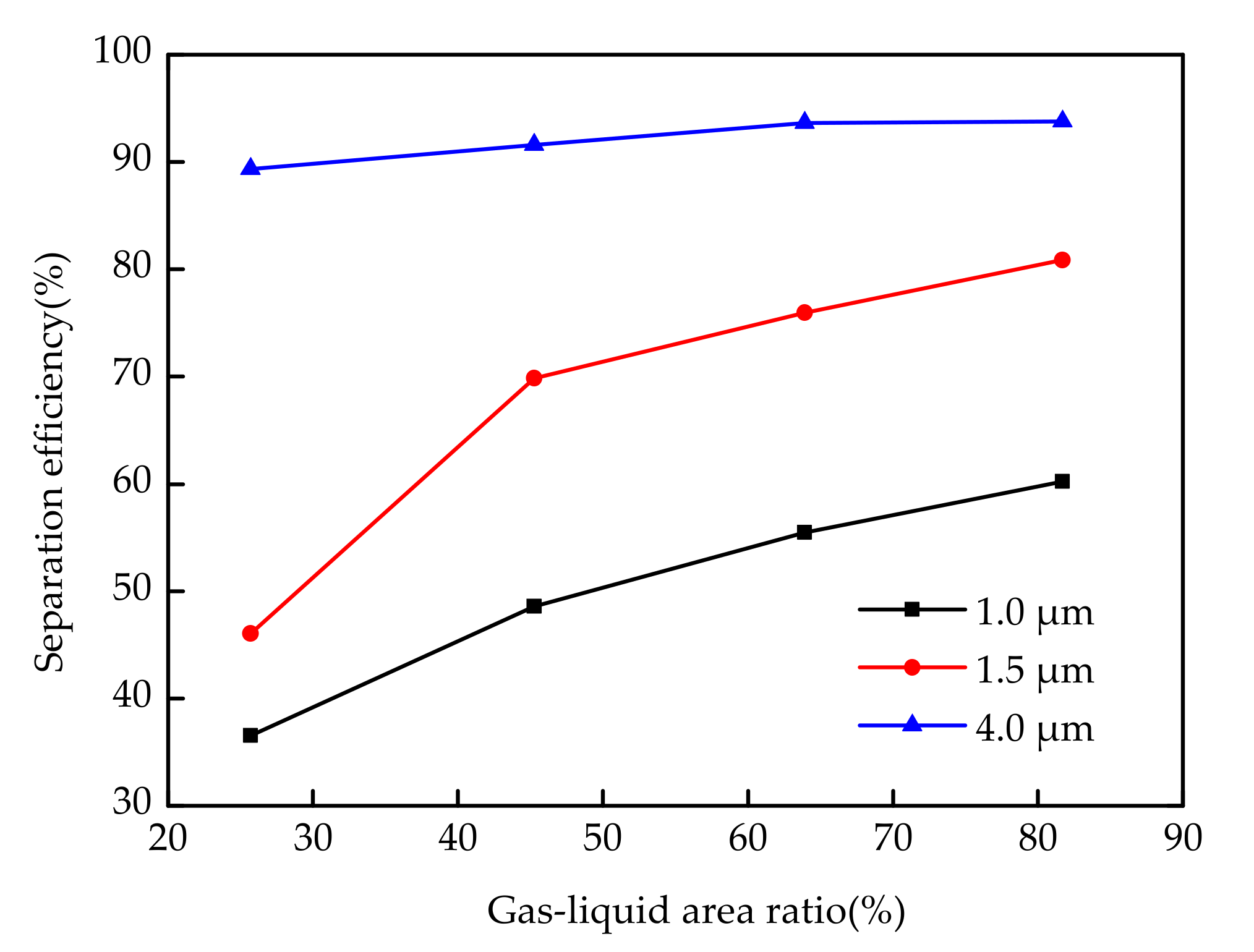
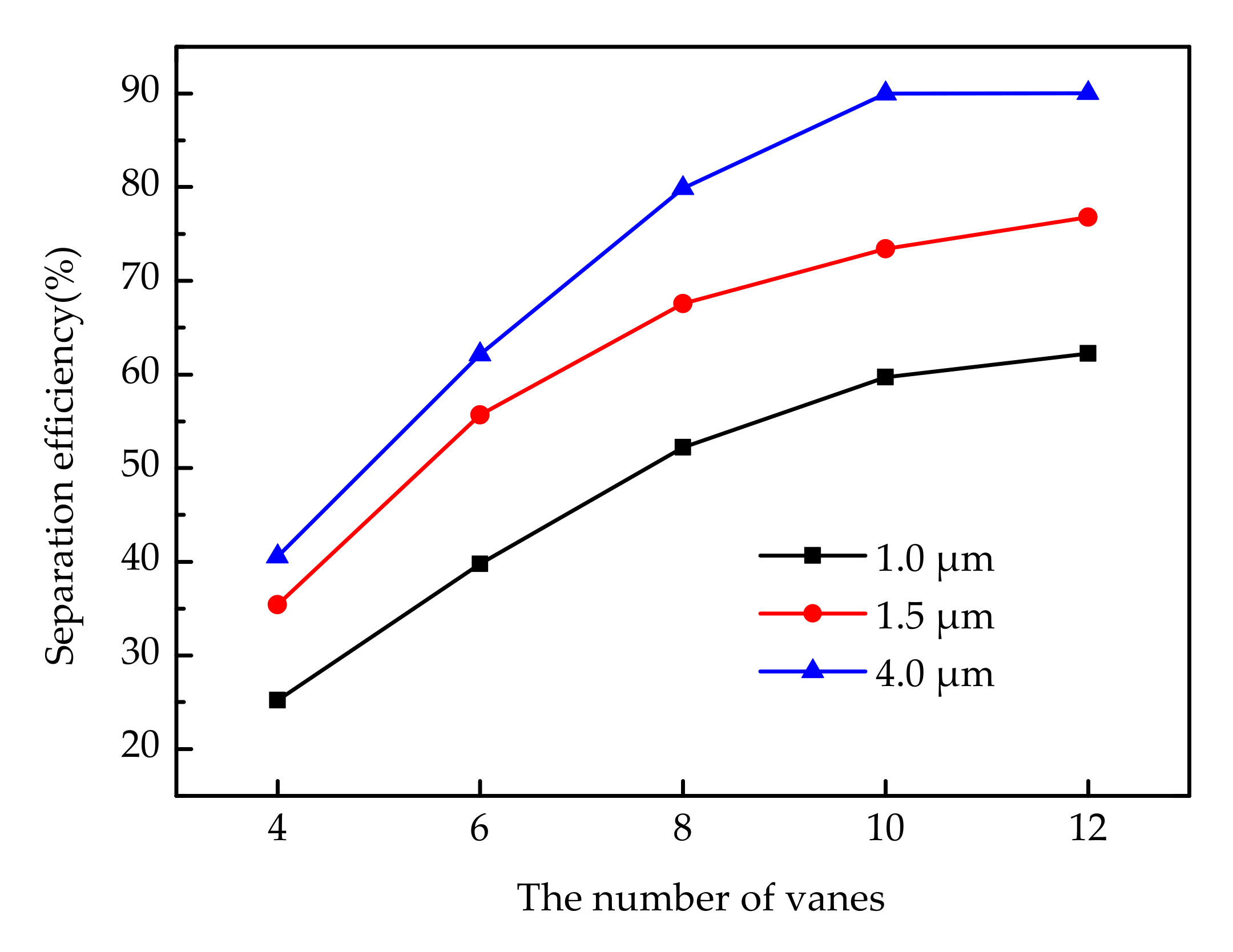
| Operating Parameters | Unit | Value |
|---|---|---|
| Ambient temperature | °C | 17.8 |
| Ambient humidity | % | 16.2 |
| Inlet pressure | MPa | 0.46 |
| Inlet temperature | °C | 14.9 |
| Inlet relative humidity of air | % | 83 |
| Inlet flow rate | m3/h | 33.8 |
© 2020 by the authors. Licensee MDPI, Basel, Switzerland. This article is an open access article distributed under the terms and conditions of the Creative Commons Attribution (CC BY) license (http://creativecommons.org/licenses/by/4.0/).
Share and Cite
Duan, Z.; Ma, Z.; Guo, Y.; Zhang, J.; Sun, S.; Liang, L. Study on Supersonic Dehydration Efficiency of High Pressure Natural Gas. Sustainability 2020, 12, 488. https://doi.org/10.3390/su12020488
Duan Z, Ma Z, Guo Y, Zhang J, Sun S, Liang L. Study on Supersonic Dehydration Efficiency of High Pressure Natural Gas. Sustainability. 2020; 12(2):488. https://doi.org/10.3390/su12020488
Chicago/Turabian StyleDuan, Zhenya, Zhiwei Ma, Ying Guo, Junmei Zhang, Shujie Sun, and Longhui Liang. 2020. "Study on Supersonic Dehydration Efficiency of High Pressure Natural Gas" Sustainability 12, no. 2: 488. https://doi.org/10.3390/su12020488
APA StyleDuan, Z., Ma, Z., Guo, Y., Zhang, J., Sun, S., & Liang, L. (2020). Study on Supersonic Dehydration Efficiency of High Pressure Natural Gas. Sustainability, 12(2), 488. https://doi.org/10.3390/su12020488




